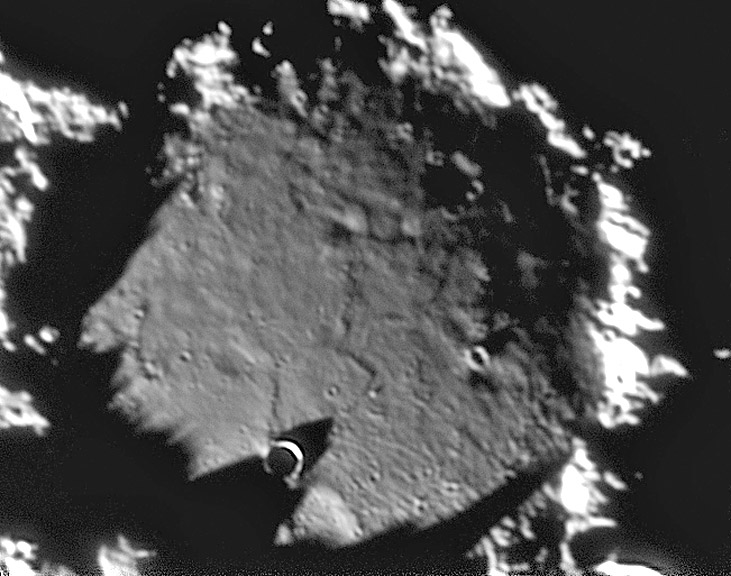November 20, 2017
Unfamiliar Territory
Originally published May 15, 2008

image by Jim Phillips, Charleston, SC
What is this rough surface that seems strange yet somewhat familiar? Its obviously deep within a crater with towering walls. There are different textures of roughness, from the small ridges and hills at bottom right, to relative smoothness with shallow depressions at left, to scarped plateaus on the right. Is that a buried channel extending from the big, shadow-filled crater at bottom left to a few bright hills at top left? Or is it an over-imaginative brain splicing together random irregularities? Is the right edge of the floor domed downward, causing the shadowing on that side? Where are we?
Chuck Wood
PS - Excitement tonight - just got new radar images of Titan from a Cassini flyby on the 12th. Great new features - watch for a press release from JPL in a few days.
Technical Details
May 12, 2008. TMB 8' F/9 @ F/45.
Related Links
Rükl plate ?
Yesterday's LPOD: Goodacre's Take
Tomorrow's LPOD: Unexpected Obliquity
COMMENTS
(1) It's the floor of Ptolemaeus during local sunrise. The small bowl-shaped crater on the floor is Ammonius (Ptolemaeus A; also called "Lyot"). There's a little bit of Herschel's northern rim visible at the photograph's lower margin (lower-right corner). North is to "about 4 to 5 O'Clock" (or "about 16 to 17 O'Clock").
-- Danny Caes.
(2) Oooooops! Should be: "there's a little bit of Herschel's SOUTH-WESTERN rim visible at the photograph's lower margin (lower right corner)".
-- Danny Caes.
(3) Amazing view... after years of observing I can honestly say that I have never seen such detail on Ptolemaeus' floor. Studying such detail on a usually smooth-looking floor is a breath of fresh air, bravo, and the discovery (?) of that rille is is fantastic (it's hard to find a random alignment of un-connected features that line-up so well but I could be wrong (hee hee).
Mark
(4) Danny, didn't know Ammonius was called 'Lyot'. There's another Lyot around the Mare Australe area I know, so don't know how this would fare with referencing which crater is the real Lyot. Also, and it's probably just an image effect, but is that light-ish area within this Lyot's central region due to light from the brighter rim (the NE rim in this photo) or is it due to light leaking through the gap area in the SW part of rim producing a kind of refractive light? Just another note -- on closeup through Map-A-Planet, Lyot looks more conical-like in nature rather than bowl-like, which might reflect upon its creation re: impact dynamics and impactor etc. John -- www.moonposter.ie
(5) John, before Ptolemaeus A was called Ammonius, it was unofficially called "Lyot" by Hugh Percy Wilkins and Patrick Moore (and by their Spanish team of moon-connoisseurs and amateur lunar observers). It is a most interesting story! (the story of Wilkins' and Moore's "new" lunar nomenclature of about a hundred names). Part of that story is mentioned in Ewen A. Whitaker's book Mapping and Naming the Moon; a history of lunar cartography and nomenclature (Cambridge, 1999). See also the moonwiki's pages for Ammonius, and Ptolemaeus (search in the ABC-gazetteer at left), and for the unofficial name "Lyot" in my (HUUUUUGE) list of unofficial lunar nomenclature and nicknames! (an ABC in four parts!!!). Take a look in Special Features Lists (also at left).
P.S.:
The weak "illumination" of Ammonius' floor is an image effect.
-- Danny Caes.
(6) Thanks Danny -- great response re: Ammonius/Lyot stuff and on the light inquiry, too. I have a copy of P Moore's old map (a reproduction that came free some years ago with a magazine), but he has down Ammonius just as A (must have been drawn before he and Wilkins got together on the new nonmenclature). I'll have to look up the history of it, but for now I think I'll stick with the 'real' Lyot as that crater being on the outskirts of Mare Australe (see Lunar Orbiter image LO4-005H3) :-)) John -- www.moonposter.ie
(7) John, it's possible that the unofficial name "Lyot" was printed on the bi-colored FALK-moonmap in one of V.A.Firsoff's books (I can't remember the name of that moonbook). Anyway, on that FALK-moonmap (gold and bluish colored) there are LOTS of unofficial names! (mostly of Wilkins' and Felix C. Lamech's lists). All the names were printed in "circumscribed-fashion" around the location of crater Tycho! (as if Tycho was the centre of the nomenclature-system). Interesting to know: Felix C. Lamech thought that Tycho was the moon's true South Pole!
-- Danny Caes.
COMMENTS?
Register, Log in, and join in the comments.



